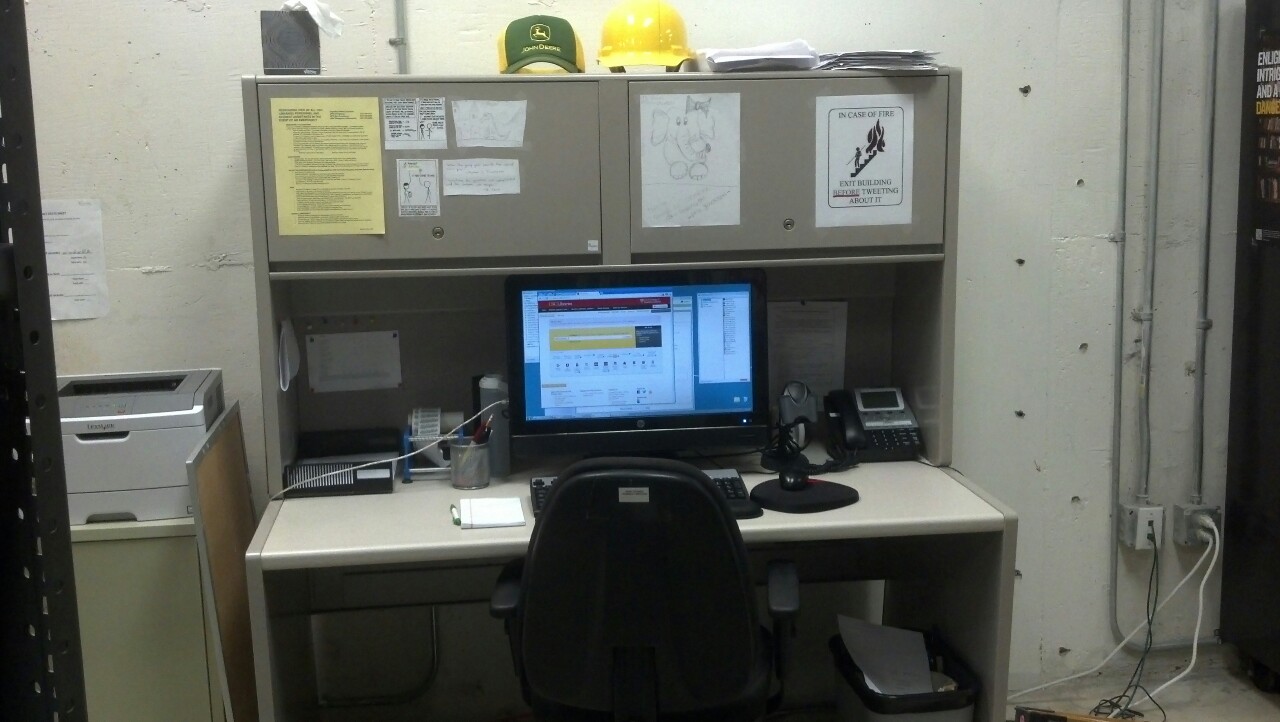A gratuitous picture of my library workspace for #gpoml. My home base is in a warehouse that is practically an industrial space.
Tag: workspace
Why your desk has wheels…
The following passage comes from the Valve Handbook for New Employees [pdf] which, according to the gaming website Polygon, may be legitimate. It is fascinating nonetheless. Special thanks to Andy Woodworth for bringing it to my attention. This comes out of a discussion on Facebook regarding my recent post on library work spaces, concerning which I’m planning a follow up post based on all the feedback I’ve received so far (which was passionate and often strongly worded!).
Why does your desk have wheels? Think of those wheels as a symbolic reminder that you should always be considering where you could move yourself to be more valuable. But also think of those wheels as literal wheels, because that’s what they are, and you’ll be able to actually move your desk with them.
You’ll notice people moving frequently; often whole teams will move their desks to be closer to each other. There is no organizational structure keeping you from being in close proximity to the people who you’d help or be helped by most.
The fact that everyone is always moving around within the company makes people hard to find. That’s why we have http://user—check it out. We know where you are based on where your machine is plugged in, so use this site to see a map of where everyone is right now.
Would you give up your office?
Three things inspired this post:
- Brian Mathews’s appeal for academic librarians to think like a startup.
- The potential for library renovations at MPOW.
- A recent conversation thread on Facebook.
A colleague of mine recently posed the following question: what would it take for you to give up your office? We were having a conversation about startup culture and types of working environments that inspire creative thinking, serendipity, and synergy (everybody drink!). In particular, we were looking at Mashable’s Startup Spaces Series. What we noticed about the offices of companies like GetGlue, Pinterest, and Yelp was that most employees didn’t have an office. They didn’t have a cubicle either. Instead, there were designated spaces (like conference rooms of various sizes, picnic tables, lounge areas) for working in groups of various sizes.
The benefit of this layout, I hope, is obvious: more conversation, more serendipitous collaborations, improved communication and collegiality. It also makes it difficult for an employee to spend his entire day behind a door or in between three foam partitions except when those moments are absolutely necessary. “Shutting everyone out” is not an option an exception to the rule rather than a daily practice in the workplace. Instead, colleagues are always working together in a shared, open space. This, of course, would require certain technological changes (i.e. abandoning our reliance on the desktop computer, strengthening wireless access points, etc.), but come on, we’re librarians. We can adapt.
When I proposed the question on Facebook, the immediate reaction was “hell no!”* Most of the people who responded cited the need for privacy: a space where they could meet one-on-one with students, faculty, and colleagues. Ok, I will grant that. But what if private spaces could be guaranteed? What if, like student study rooms, a small number of private spaces could be set aside (and immaculately decorated) for consultations and private meetings?
Instead, work spaces would form organically based on the resources needed (number of people, projector access, proximity to coffee machine). Conversations would mostly be public and, unless privacy was needed, would allow any member of the office team to contribute. Work areas could be opened up (due to the lack of walls) and not only provide additional space for creative work (whiteboards, e.g.) but offer a more aesthetically pleasing environment (open air, natural light, minimal number of metal filing cabinets). Again, I point to some of the office spaces linked above.
Personally, I believe we are too attached to our work spaces. Over time, we develop a sense of ownership which, although charming, is anathema to creative work. On the other hand, there is good evidence to suggest that the best ideas arise from collaboration, conversation, and distributed mental work despite the potential for distraction.
The future of libraries in higher education demands new approaches to service and new [collaborative] ways of getting things done. How can we even begin to plan for this future when we rarely come together? It is high time we changed the way we work; else, how can we expect to innovate? As Mathews points out:
We can’t hire a few creative and improvisational individuals and expect them to deliver new service models if the work culture is not ready for new service models.
Let’s break down the walls (literally) that separate us and explore new ways of working together. What, at worse, would happen if we failed? And what if we succeeded…
Update: Anthony Molaro, a forward thinking librarian that I greatly admire, has also written on this topic: Department Silos II or Why You Need a New Workspace: “I have seen libraries create powerful spaces for patrons, but I have yet to see a library create appropriate spaces for 21st century librarians.”
- Personally, I am suspect when any proposition inspires immediate and fierce objection.
